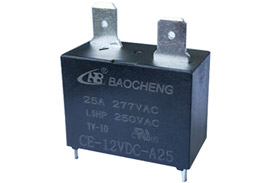Affect the life of Power Relay at these key points.
First, the contact is loose and cracked back
The contact is the electrical contact part of the relay to complete the switching load. The contacts of some products are press-fitted by riveting. The main disadvantages are loose contact, cracked contact or excessive positional deviation. This will affect the contact reliability of the T78 Relay. The loosening of the erasing point occurs, which is caused by an unreasonable size of the mating portion of the reed and the contact or an improper adjustment of the riveting pressure by the operator. Contact cracking is caused by excessive material hardness or too much pressure. For different materials, the contacts are made of different materials. Some of the higher hardness contact materials should be annealed for contact manufacturing, riveting or spot welding. The manufacturing of the contacts should be careful. Since the materials have tolerances, the length of each cut should be determined after trial and error. Contact manufacturing should not cause flashing, stumping and underfilling. The contact riveting is caused by the operator not correcting the touch and misaligning the upper and lower touches. Contact damage, contamination, oil contamination and iron filings on uncleaned tools.
Second, the relay parameters are unstable
Power Relay
A considerable part of Power Relay's components are riveted and assembled. The main problem is that the riveting is loose or the bonding strength is poor. This kind of fault will make the relay parameters unstable, the parameters change greatly under high and low temperature, and the resistance to mechanical vibration and impact resistance is poor. The main cause of this problem is the poor condition of the riveting parts, the improper placement of the parts, the unqualified quality of the work tools or the inaccurate installation. Therefore, it is necessary to carefully check whether the tool and the rivet parts meet the requirements before the welding.
Third, electromagnetic system riveting deformation
After the riveting, the parts are bent, skewed, and the thick black is difficult to assemble or adjust the next process, and may even result in scrapping. The main reason for this problem is that the riveted parts are too long, the force is not too short when the riveting is too short, the assembly deviation or the design size is wrong, and the parts are improperly placed. When riveting, the operator should first check the size of the parts, the appearance, and whether the tool is accurate. If the tool is not installed, it will affect the assembly quality of the electromagnetic system or the deformation of the core and the thickness of the pier.
Fourth, glass insulator damage
The glass insulator is made of metal pins and glass sintered. It is easy to bend the pins during inspection, assembly, adjustment, transportation and cleaning. The glass insulators are dropped and cracked, resulting in air leakage and insulation and pressure resistance degradation. Rotation also causes the contact reed to shift, affecting the reliable continuity of the product. This requires the operator of the assembly to handle lightly during the entire process of relay production. The components should be placed neatly in the transfer box. When assembling or adjusting, it is not allowed to pull or twist the lead. Our company is Power Relay Supplier, welcome to come to us.


评论
发表评论